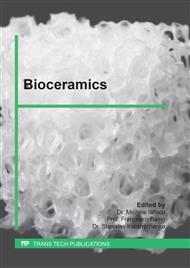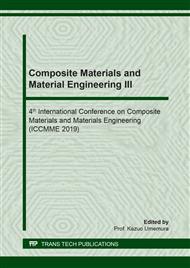[1]
L. L. Hench, R. J. Splinter, W. Allen, and T. Greenlee, Bonding mechanisms at the interface of ceramic prosthetic materials,, Journal of Biomedical Materials Research Part A, vol. 5, pp.117-141, (1971).
DOI: 10.1002/jbm.820050611
Google Scholar
[2]
S. Heidari, T. Hooshmand, B. E. Yekta, A. Tarlani, N. Noshiri, and M. Tahriri, Effect of addition of titanium on structural, mechanical and biological properties of 45S5 glass-ceramic,, Ceramics International, vol. 44, pp.11682-11692, (2018).
DOI: 10.1016/j.ceramint.2018.03.245
Google Scholar
[3]
M. Riaz, R. Zia, F. Saleemi, T. Hussain, F. Bashir, and H. Ikhram, Effect of Ti(+4) on in vitro bioactivity and antibacterial activity of silicate glass-ceramics,, Mater Sci Eng C Mater Biol Appl, vol. 69, pp.1058-67, Dec 1 (2016).
DOI: 10.1016/j.msec.2016.08.022
Google Scholar
[4]
A. Thomas, K. C. R. Kolan, M. C. Leu, and G. E. Hilmas, Freeform extrusion fabrication of titanium fiber reinforced 13-93 bioactive glass scaffolds,, J Mech Behav Biomed Mater, vol. 70, pp.43-52, (2017).
DOI: 10.1016/j.jmbbm.2016.12.025
Google Scholar
[5]
Y. Jiang, H. Ning, C. Tian, B. Jiang, Q. Li, H. Yan, et al., Single-crystal TiO2 nanorods assembly for efficient and stable cocatalyst-free photocatalytic hydrogen evolution,, Applied Catalysis B: Environmental, vol. 229, pp.1-7, (2018).
DOI: 10.1016/j.apcatb.2018.01.079
Google Scholar
[6]
C.-L. Huang, W. Fang, I. H. Chen, and T.-Y. Hung, Manufacture and biomimetic mineral deposition of nanoscale bioactive glasses with mesoporous structures using sol-gel methods,, Ceramics International, vol. 44, pp.17224-17229, (2018).
DOI: 10.1016/j.ceramint.2018.06.180
Google Scholar
[7]
A. E. Pazarçeviren, A. Tahmasebifar, A. Tezcaner, D. Keskin, and Z. Evis, Investigation of bismuth doped bioglass/graphene oxide nanocomposites for bone tissue engineering,, Ceramics International, vol. 44, pp.3791-3799, (2018).
DOI: 10.1016/j.ceramint.2017.11.164
Google Scholar
[8]
Y. B. Veytskin, V. K. Tammina, C. P. Bobko, P. G. Hartley, M. B. Clennell, D. N. Dewhurst, et al., Micromechanical characterization of shales through nanoindentation and energy dispersive x-ray spectrometry,, Geomechanics for Energy and the Environment, vol. 9, pp.21-35, (2017).
DOI: 10.1016/j.gete.2016.10.004
Google Scholar
[9]
E. Vernè, S. Ferraris, C. Cassinelli, and A. R. Boccaccini, Surface functionalization of Bioglass® with alkaline phosphatase,, Surface and Coatings Technology, vol. 264, pp.132-139, (2015).
DOI: 10.1016/j.surfcoat.2015.01.001
Google Scholar
[10]
Y. Li, W. Hu, G. Han, W. Lu, D. Jia, M. Hu, et al., Involvement of bone morphogenetic protein–related pathways in the effect of aucubin on the promotion of osteoblast differentiation in MG63 cells,, Chemico-Biological Interactions, vol. 283, pp.51-58, (2018).
DOI: 10.1016/j.cbi.2018.02.005
Google Scholar
[11]
Y. Wan, T. Cui, W. Li, C. Li, J. Xiao, Y. Zhu, et al., Mechanical and biological properties of bioglass/magnesium composites prepared via microwave sintering route,, Materials & Design, vol. 99, pp.521-527, (2016).
DOI: 10.1016/j.matdes.2016.03.096
Google Scholar
[12]
A. Cahyanto, K. Tsuru, and K. Ishikawa, Effect of Setting Atmosphere on Apatite Cement Resorption: An In Vitro and In Vivo Study,, Journal of the Mechanical Behavior of Biomedical Materials, (2018).
DOI: 10.1016/j.jmbbm.2018.08.021
Google Scholar



